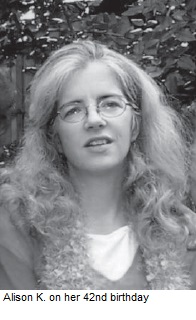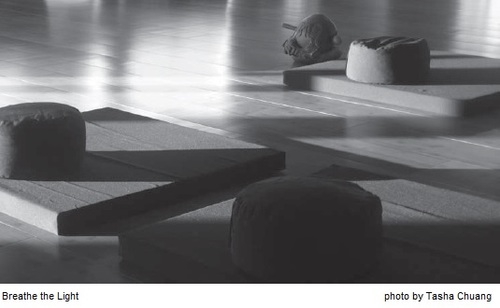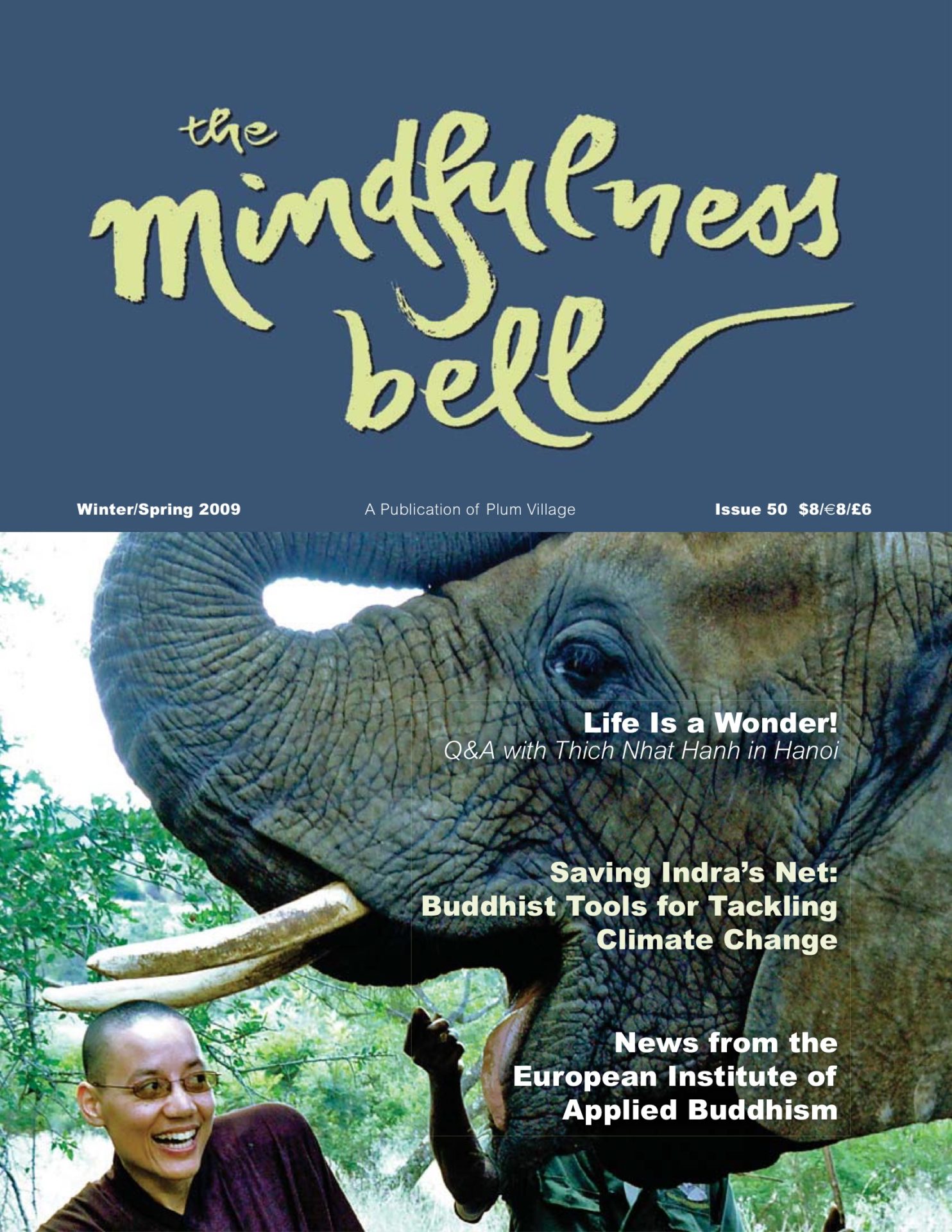The Dharma of Caring for Alison K.
By Lauren Thompson

I never knew Alison K. when she was well. By the time both she and I were regularly attending the Rock Blossom Sangha, in Brooklyn, New York, she was a few months into a diagnosis of inoperable brain cancer. Her tumor was a glioblastoma, the worst kind. According to the statistics, she had a year,
The Dharma of Caring for Alison K.
By Lauren Thompson

I never knew Alison K. when she was well. By the time both she and I were regularly attending the Rock Blossom Sangha, in Brooklyn, New York, she was a few months into a diagnosis of inoperable brain cancer. Her tumor was a glioblastoma, the worst kind. According to the statistics, she had a year, at most two years to live. She was forty-one.
This would be my first intimate encounter with the reality of death, with the reality of someone I knew dying. For the Sangha, it would be our time to experience most poignantly what it means to take refuge in Sangha.
Having brain cancer is difficult enough. For Alison, the difficulty was compounded by her family situation. She was living alone; her parents had both died years earlier; she had two sisters, but one was unable to help, and the other was able to visit only periodically. For reasons known best to Alison, she had decided to grant three close friends the medical, financial, and legal powers of attorney. They all loved her and were deeply committed to her care, but even as a group they couldn’t meet all of her emotional, spiritual, and physical needs. And so the degree of refuge that Alison sought in Sangha was profound. As her illness progressed and her needs grew more intense, the compassion that arose within the Sangha, both as individuals and as a body, was just as profound. For me, the experience was one of watching a miracle unfold, as beautiful and poignant as a lotus flower.
Like a flower, this bud of compassion unfurled in stages. At first, only one or two members were involved in her life outside of Sangha. For most of us, our involvement consisted of listening deeply to her words during Dharma sharing. She shared all of her pain and confusion, her fear and occasional joy and ease, and for me, as for many, her need was sometimes overwhelming. I felt a strong impulse to close her out, to guard myself from her pain. I felt the discomfort of strong aversion, and also the discomfort of disapproving of my own aversion. Was I really so selfish and weak that I would turn away from a Sangha sister who was dying of cancer? At times I felt such distress that I could barely sit still.
But the practice of deep listening helped me through these storms. Week after week, the instructions for Dharma sharing reminded me to observe my reactions without judgment, to simply bear witness to her truth, to listen for what may not be said in words, and to attend to everything with great gentleness. After some time, I found that my response had changed. As Alison spoke at length about her life’s present conditions, I heard the heart message beneath her words: “I suffer. Please help.” And the bud of compassion began to open.
It was then that I was able to reach out personally to Alison, and it was then that our brief but intense friendship began. One fall afternoon we met for tea, and we spent hours in conversation that dispensed with the usual preliminaries and small talk. We connected very deeply. Within weeks, Alison’s condition worsened, and through the winter and spring she spent more time in hospitals and hospice than out. Her capacity for language began to deteriorate, so that at times conversation was not possible. Yet our connection remained strong; in fact, it became only stronger.
What she needed was for me to be fully present to her, and during my brief visits, often no more than an hour once or twice a week, I found I was able to offer this. Whether that meant laughing over a movie with her, staying with her through times of confusion or distress, or holding her hand as she slept, it was tremendously rewarding to be with her in this way. It could also be draining and upsetting. I learned I had to take care of myself, as well, in order to take care of her. Layer by layer, the petals opened.
Blessed... Blessed... Blessed
As Alison’s condition worsened, many others in the Sangha were also drawn to be personally involved. Some offered regular companionship. Others helped to move her belongings into storage when she had to leave her apartment. Some visited as they could, or provided occasional transportation; others offered support to Alison’s closest caregivers. Some simply held her in their thoughts.
And Alison expressed her gratitude for it all. A precious memory for the Sangha is a tea ceremony which Alison attended in the fall. Alison began by sharing how thankful she felt for the support she had received, the friendship, the love. Then she sang a song for us all. It was a setting of the Beatitudes, which she sang beautifully in a low, warm, alto voice. “Blessed … blessed … blessed are the poor in heart, for they shall be comforted ….” She sang with her eyes closed, her hands crossed over her chest, as if her heart could not contain all that it must hold.
As the months went on, Alison would at times be able only to whisper “Thank you” or “So sweet,” or smile her luminous smile. Even if the most she could do was gaze into our eyes with warm intensity, she found a way to convey her gratitude.
Living in the Moment
We found that, even if we were only marginally involved, caring for Alison required that we shed expectations. Her condition would worsen and then dramatically improve, so we never knew what to expect from any visit. One day, she may be quite talkative. The next, she may be almost comatose, as her heavily medicated body stabilized after a major seizure.
Our sense of how much longer she might live was in constant flux. She moved back and forth between supported independence and hospice, between functioning and incapacity. Each transition felt like the end of one era and the beginning of another, but how long that era might last was anyone’s guess, even the experts’. “Don’t-know mind” was the only frame of mind that could contain this fluid reality. There was no definite future to plan for together – the customary illusion of “the future” could find no fixed mooring under circumstances like these. There was only the present moment.
We in the Sangha all contended with the feeling of helplessness, of having to accept that we could not give Alison what she really wanted, a reprieve from early death. And much as we might wish to offer our comfort, we couldn’t know how she would receive it. She might greet us warmly and ask about ourselves. Or she might barely waken. Or, for others more than for me, Alison might display the impulsive fury of a frustrated child, straining every fiber of her caregivers’ patience. We consoled each other, in person, by phone, and through an e-mail care circle, that our loving presence could be only helpful. We also encouraged each other to take breaks, to give only as much as we could without feeling resentful.
The challenges were many, but the gifts were many, too. I know that for myself, time I spent with Sangha sisters and brothers whose visits happened to coincide with mine often led to long, intimate conversations. Being with Alison awakened in many of us the sense of how precious every moment with another being truly is. Knowing this, how could we be anything but completely authentic and kind? For me, these encounters provided moments of deep healing of the terrible loneliness that had always left me feeling set apart and unknown. Through Alison’s dying, I had fleeting glimpses of interconnectedness with all of life, of true interbeing.
The Most Beautiful Gift
Certainly the clearest experiences I had of interbeing were with Alison herself. During one visit in early spring, she was alert and eager to communicate, but her speech was confused. Still, her heart intent was very clear. She insisted that I not leave until I had some “Christmas.” She knew that wasn’t what she meant, and after a few moments she landed on the right words: ice cream. An aide brought us each a cup of ice cream, and when she couldn’t finish hers, she offered it to me. I told her that more ice cream would probably upset my stomach. She held her cup out to me, saying, “Then eat it carefully. I’m giving it to you carefully. So you eat it carefully.”

As I took the cup, I was moved almost beyond words by her offer, which was indeed full of caring. She seemed to be passing to me, not just ice cream, but her life, asking me to enjoy for her the portion that she would not be able to enjoy herself.
“Alison,” I said, “you are a good friend.”
“Yes, but no,” she said. “You don’t understand. I really like you. No, not like. I mean, I don’t want to be …”
She started gesturing broadly with her hands, and I suggested, “You don’t want to be all lovey-dovey?”
“Right,” she said. “But I love you. I really do.” “I love you, too,” I said, “I do.”
And for many moments there was only silence between us. There was a communication then that was not really between “Lauren,” with one personal history, and “Alison,” with another. We barely knew each other on that level. It was a connection of our very being. It was a moment of such joy and sadness. It was the most beautiful gift. A “Christmas” gift indeed.
When I was ready to leave, she patted her bald scalp and said, “Next time we have class, I’ll wear my hat.”
I smiled. “You mean next time I visit?”
“Yes, that’s what I mean.”
“You look lovely just like this,” I said. I kissed her forehead, said good-bye, and left. That was our last conversation. Within a week, she passed away.
To the Other Shore
I knew Alison well for only six months. I knew very little about her family or her relationship history, or what kind of music she liked. But through her dying, I caught a glimpse of our fundamental interbeing. Along with others in the Sangha, I felt that I was able to step, now and then, in the footprints of the bodhisattvas, responding with compassion to Alison’s condition, which was, ultimately, the human condition. I sensed, moments at a time, how precious life is. I saw how Sangha can be a boat that carries us safely to the other shore — it carried Alison, and it carries me still.

Alison K. passed from this life on March 27, 2007, at the age of forty-two.

Lauren Thompson, Compassionate Eyes of the Heart, practices with the Rock Blossom Sangha in Brooklyn, NY. She is a children’s book author, presently working on an adult memoir of her experiences with Alison K.

